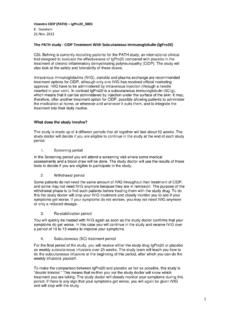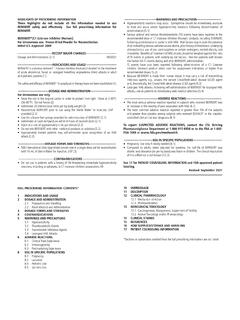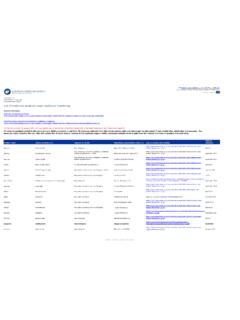Transcription of Guidelines for Physical and Occupational Therapy
1 Guillain-Barr Syndrome,CIDP and VariantsGuidelines for Physical and Occupational TherapyA publication of the GBS/CIDPF oundation InternationalGuidelines for Physical and Occupational TherapyProvided through an educational grant fromCSL BehringDear Therapist/Therapist Assistant, Thank you for taking a few moments to learn more about what your patient with Guillain-Barr syndrome (GBS), chronic inflammatory demyelinating neuropathy (CIDP) or a variant has been experiencing and how you better can help them on their road to recovery. Perhaps they already are well along on their journey, or they just may be getting started, but their experience to this point undoubtedly has been a frightening and stressful one. Some of a patient s greatest fears regarding Therapy are that their therapist will not know what to do with them and/or will not understand their limitations, or that Therapy will be so painful and/or hard that they will not be able to move the next day.
2 We know that therapists and therapist assistants have a solid base of academic and clinical knowledge from which to work, but many have not encountered GBS or CIDP directly during their careers. Accordingly, the GBS/CIDP Foundation International (the Foundation ) has published this booklet and encourages patients to share it with their Physical and Occupational therapists. Regardless of your familiarity with GBS or CIDP, your taking the time to review this information will offer your patient peace of mind in knowing that you are interested in their care and sensitive to issues that are unique to their condition. What are GBS, CIDP and related disorders?GBS and CIDP are acquired immune-mediated inflammatory disorders of the peripheral nervous system. Their etiology is not completely understood, and neither disorder is contagious. Most GBS cases appear to be precipitated by an infectious respiratory or gastrointestinal illness with diarrhea. In the and Europe, 60 to 80 percent of GBS cases occur within four weeks of a preceding infection.
3 For an as yet unknown reason, the body s response to the infection goes awry and the immune system attacks the myelin and sometimes the axons of the peripheral nerves. As a consequence, neurological signals are slowed, altered or blocked G B S / C I D P F O U N D AT I O N I N T E R N AT I O N A L altogether, resulting in paresthesias ( numbness, tingling, crawling skin ), loss of sensation and deep tendon reflexes, progressive muscle weakness, often general fatigue, sometimes pain and a number of other possible secondary complications. Motor and sensory involvement is symmetrical in proximal and distal muscles with symptoms progressing in an ascending fashion, the lower limbs usually being affected first. In severe cases, autonomic nervous system dysfunction also can occur, the presence of which is suggested by orthostatic dizziness, bowel and bladder function complications and/or cardiac symptoms. Unlike multiple sclerosis and amyotrophic lateral sclerosis ( Lou Gehrig s disease), GBS and CIDP generally do not cause damage to the central nervous system, although GBS patients may experience difficulty with swallowing (dysphagia), facial drooping and other deficits of the lower cranial nerves.
4 Neither condition affects a patient s cognition. Guillain-Barr Syndrome Guillain-Barr syndrome, also called acute inflammatory demyelinating polyneuropathy (AIDP), affects one to two new persons per 00,000 population each year. It can strike anyone without warning regardless of gender, age or ethnic background. About 50 percent of patients initially develop abnormal sensations such as tingling of the feet or fingers; twenty-five percent initially develop muscle weakness ( difficulty climbing stairs, getting up from a chair and/or cramping) and 25 percent begin with a combination of abnormal sensations and weakness. Pain is also a common symptom, sometimes experienced as deep aching or cramping in the buttocks, thighs or between the shoulders. Disability caused by GBS generally progresses over the course of a few days to four weeks, with weakness starting distally and ascending in a matter of hours to days. At the peak of the condition s progress, many patients experience flaccid paralysis of nearly all skeletal muscles, with talking, swallowing and breathing frequently being affected.
5 Seventy percent of patients lose some strength in respiratory muscles that can lead to shortness 2 G B S / C I D P F O U N D AT I O N I N T E R N AT I O N A Lof breath; in about one third of patients, intubation and a ventilator temporarily become required. Consequently, most newly diagnosed patients are placed in an intensive care unit for monitoring. Plasma exchange (PE) or a high dose of intravenous immune globulins (IVIG) often hasten recovery. Corticosteroids are not helpful for GBS, but frequently are used to treat CIDP. Fortunately, GBS typically is self-limiting with improvement usually beginning spontaneously after weakness maximizes. The death rate is approximately three percent, and the recurrence rate less than five percent. Most patients eventually reach a full or nearly full recovery. Many patients will walk without aid after three months and experience only minor residual symptoms by the end of the first year following onset. Nevertheless, recovery can be extremely slow (stretching over the course of six months to two years or longer) and five to twenty percent of patients are left with significant residual symptoms that lead to long-term disability and prevent a successful return to their prior lifestyle or occupation.
6 Acute Motor Axonal NeuropathyThis variant of GBS initially was recognized by westerners as epidemics of paralysis in children in rural northern China and first was named the Chinese paralytic syndrome. It often follows diarrhea from Campylobacter jejuni, does occur occasionally in the western world, but unlike classic GBS does not affect sensory nerves, and more often progresses sufficiently to require ventilator support. Medical management and Occupational and Physical Therapy methods (see below) are the same as for Fisher SyndromeMiller Fisher syndrome (MFS), named after C. Miller Fisher, MD, who described the disorder, is an uncommon variant of GBS. It consists of the triad of areflexia, external ophthalmoplegia, that is, weak eye muscles that cause diplopia, and ataxia. Both the double vision and ataxic gait can contribute to impaired activities of daily G B S / C I D P F O U N D AT I O N I N T E R N AT I O N A L living. Clinical features of MFS often accompany GBS.
7 Principles of care for GBS also are applicable to Inflammatory Demyelinating PolyneuropathyCIDP is a chronic counterpart to Guillain-Barr syndrome, and also is characterized by symmetrical weakness and sensory changes. New cases of the condition are rare compared to GBS .5 to .6 new patients per ,000,000 population each year but because CIDP can persist for years, there are estimated to be as many as eight cases per 00,000 population, or five to nine thousand people in the at any one time. In contrast to GBS, CIDP develops slowly, often over the course of two months or longer. It can manifest in a variety of patterns; however, the most common is a series of recurrent relapses and remissions of ascending weakness over the course of years. Occasionally, the disorder may run a slowly progressive deteriorating course without of its typically slowly progressive nature, CIDP can present symptoms for months or longer before activities of daily living are impaired and the disorder is diagnosed.
8 Once it is determined that a patient has CIDP, first line treatment choices are corticosteroids, plasmapheresis (plasma exchange) or intravenous immunoglobulin (IVIG). In contrast to GBS, breathing, swallowing and speaking are rarely affected, though it is still important to establish a diagnosis and set a course of treatment as soon as possible. If left untreated, or if treatment is significantly delayed, CIDP can lead to severe nerve damage that may not be entirely recoverable. In fact, reinnervation and long-term disability rates are worse for patients with CIDP than for those with GBS, with the likelihood of progression and recurrence being much higher. Multifocal Motor NeuropathyMultifocal motor neuropathy (MMN) is a rare chronic inflammatory neuropathy characterized by episodes of right and/or left-sided, , asymmetric, distal limb weakness, of the upper more often than the lower limbs. Thus weakness may occur at the wrist, fingers and/or ankles and reflects inflammation G B S / C I D P F O U N D AT I O N I N T E R N AT I O N A Lof their motor nerves with slowed conduction.
9 The disorder can extend over two to as long as 20 years or more. Nerve conduction tests with selective nerve mapping aids the diagnosis. Because of its slow and variable presentation, MMN may not be recognized readily. Over time, ongoing weakness may lead to muscle atrophy. Fasciculations may occur. Treatment with IVIG is usually beneficial but not PE or corticosteroids. Various immunosuppressive drugs have been tried with variable principles of OT and PT care for GBS and CIDP as described below apply to MMN. The Plan of Care should be customized to the individual patient s disability. Orthotics may be indicated to compensate for distal is your patient feeling?In order to maximize the impact of your Plan of Care on your patient s prognosis, it is important to understand that their emotions frequently will override reason. When you first meet, the patient likely will have thoughts such as: Will I ever walk again? and When will I get back to normal, or will I?
10 Even when it is time to be discharged from services, they likely will be asking themselves, Will this ever happen to me again? The therapist always should be encouraging and hopeful regarding the patient s recovery without making promises about the degree of recovery or the time frame. It can, however, be said with confidence that the vast majority of patients return to some level of independence. The following is a list of concerns that should be recognized as you work with your patient: Fear and Anxiety Your patient went from being completely independent to experiencing at least some level of dependence on others for no apparent reason and in a short amount of time. If they are still in the acute stage of the condition, they and their caregivers are looking desperately for answers and may be thinking the worst. Once stabilized, your patient probably will continue to experience some anxiety during quiet times alone or G B S / C I D P F O U N D AT I O N I N T E R N AT I O N A L 5during treatment.








